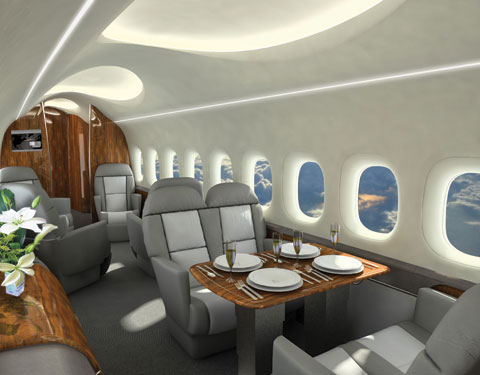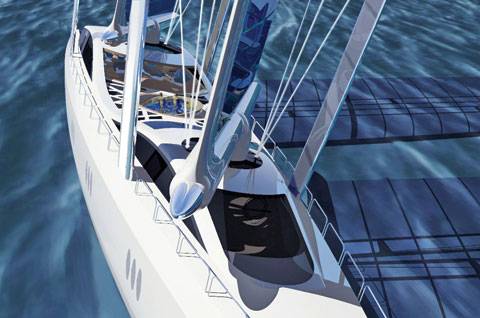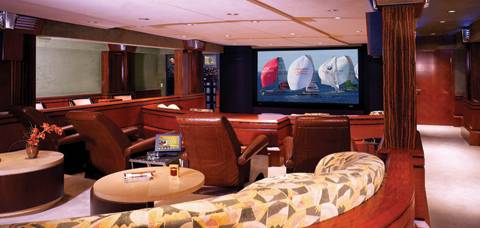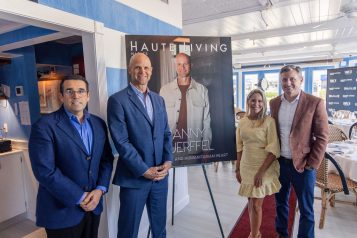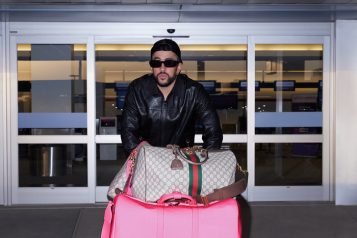The critical innovation is in the wings.
In the age of myth, Aerion, the marvelous steed begat by the gods, was uncatchable. Homer sang of the black-maned mount of heroes born to Demeter, goddess of the green earth, and Poseidon, god of the tumultuous sea. Today, it seems only fitting that the next businessmen (and businesswomen) to graze the heavens beyond the speed of sound will do so aboard their own Aerion, the world’s first Supersonic Business Jet. Modern conquerors, who do their slaying at the negotiating table, will be well-served by the mighty Mach 1.6 speed of the first American-born supersonic jet in private use.
A totem of aeronautic glory passed from the earth when the Concorde, the only commercial supersonic fleet, was grounded in 2003. Since then, the speed of sound has only been challenged by military operatives. Private companies have not lacked the technology, just the ambition. But now, a project deep in the American desert seeks to change all that by 2014. The Aerion Corporation embarked on this epic quest in Reno, Nevada, in 2002 and officially unveiled plans for the SBJ in October of 2004.
Twin Pratt & Whitney JT8D-219 engines will slingshot as many as 12 executives up to 4,000 nautical miles at a top speed of Mach 1.6, and do so safely and efficiently, even at heights of 51,000 feet. This same engine is trusted by one-third of the world’s airliners-one will take off somewhere across the globe before you finish this sentence. Tamped down to just 19,600 pounds of thrust, the engines are expected to enjoy a comfortable 3,000 flight hours between overhauls. The needle-nosed craft with vicious looks will stand at 148.3 feet in length, but will require a runway of just 6,000 feet (comparable to your run-of-the-mill subsonic business jets).
The critical innovation is in the wings. Natural laminar flow technology patented by the Aerion Corporation reduces the total airframe drag by 20 percent, so the sharp-winged marvel slips through the sky on less power. The Concorde, like most aircraft, relied on the delta-wing configuration that dominated the 20th century. Aerion is betting the 21st century will be the domain of the NLF wing.
Time and money, however, are the SBJ’s sweetest selling points. Supersonic speed at the same cost per nautical mile as a Gulfstream 550 (who has a top speed of a timid Mach .885), and two-thirds less than the larger Boeing Business Jet (Mach .82), makes the SBJ feasible, as well as fantastic.
But it’s the flying times that seal the deal. Even though regulations, like U.S. Federal Aviation Regulation 91.817, make supersonic flight over-land illegal, the SBJ can cruise at Mach .98 over land, thus beating out lesser jets like today’s fastest that clock just Mach .92-the Citation X and the Gulfstream 650 (anticipated). Over sea, there’s just no comparison.
Times like New York to Paris in four hours and 14 minutes, New York to Tokyo in nine hours, 33 minutes (with a one hour refueling stop in Anchorage), New York to Miami in one hour, 33 minutes, and the overland route from NY to Los Angeles in four hours, 19 minutes speak for themselves.
Times out of Dubai are equally scorching. The long range puts all of Europe, Africa, and most of Asia in play for non-stop flights. The supersonic option saves one hour and 45 minutes going to London, two hours to Tokyo, and three hours and 19 minutes to Singapore. On the SBJ, the distance between Dubai and New York is a mere nine hours, 36 minutes, with a stop in Lisbon to gas up.
These numbers have wooed more than 50 buyers already. Considering the jet’s ultimate $80 million price tag, this is no small feat and more than enough to cover the $1.2 billion projected development costs. Considering the planned run of 300 units, profitable is what this company plans to be.
The corporation is accepting Letters of Intent that come with a $250,000 deposit (refundable if the SBJ never takes wing). When Aerion first opened its book at the Dubai Air Show in November 2007, 20 buyers jostled for the first spots on the list. Though the corporation is jealously protective of this list, Princely Air, a Pakistani private jet charter company, Sheik Rashid, part of the UAE’s ruling family, and Tarek bin Laden, half-brother to the most wanted man on the planet, are confirmed buyers.
With a pedigree befitting a corporation named after a stallion born to the immortals, the Aerion Corp has little trouble assuaging the fears of potential buyers who bristle at supersonic promises, despite the fact that the corporation has yet to line up a manufacturer.
Fort Worth native Robert M. Bass sits as chairman of Aerion, after making his bones as a lead investor of the Oak Hill partnerships (which manages more than $25 billion of investment capital). Fleshing out the board, former CEOs of Galaxy Aerospace and Learjet join Boeing’s former program managers. Scientists with DARPA credentials and engineers with history with the Department of Defense make up the development team. Aero Toy Store manages sales in the Americas, and the rest of the world is left in the capable hands of Zurich-based ExecuJet.
The other half of the supersonic story takes place in the Nevada desert, with its own epic twist. J. Michael Paulson, son of Allen Paulson, the founder of Gulfstream, founded Supersonic Aerospace International LLC in 2000 to chase his father’s white whale. His Quiet Supersonic Transport was unveiled at the very same National Business Aviation Association convention as the SBJ.
In 1989, Paulson the elder enlisted Soviet design bureau Sukhoi to launch the supersonic S-21. Problems with sonic boom mitigation, engine durability, and corporate commitment harpooned this project. Phoenix-like, Paulson the younger presented plans for an aircraft that produces a sonic boom signature 1/100th of the Concorde’s, hinting at the possibility of supersonic speed over land.
A StrategyOne market study commissioned by Aerion in 2005 tested the waters, accounting for a competing, faster-over-land alternative. Still, the consulting firm swears by projected demand figures for 500 Aerion SBJs in the first 20 years of production. The QSST’s higher technical, market, and regulatory risk versus the earlier availability and safer economic bet of the SBJ seem to be enough to seduce a significant portion of the market.
The name Aerion means braver, stouter, and bolder-adjectives that naturally apply to the first private jet company to grab commercial air travel’s third rail with both hands. In as soon as six years, the supersonic drought could be snapped. No matter the outcome of this duel in the desert, the next private supersonic jet company will be American based, epically conceived, and, perhaps most vitally, financially solvent.







